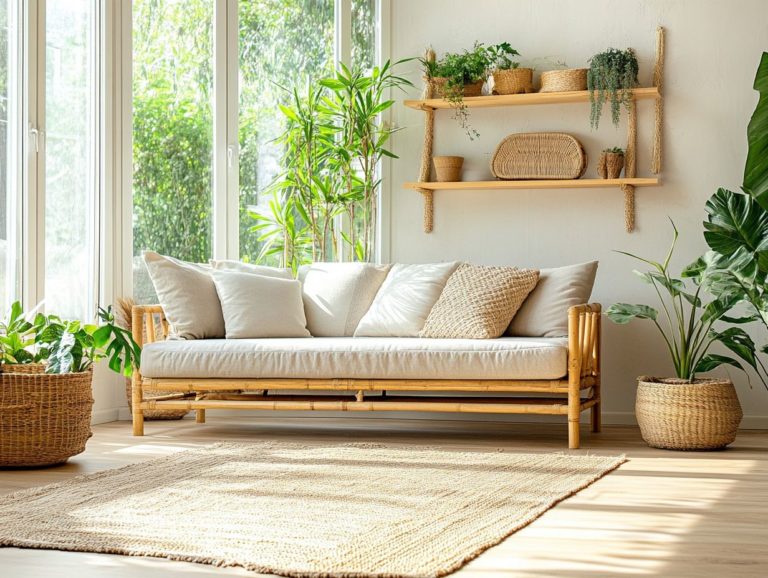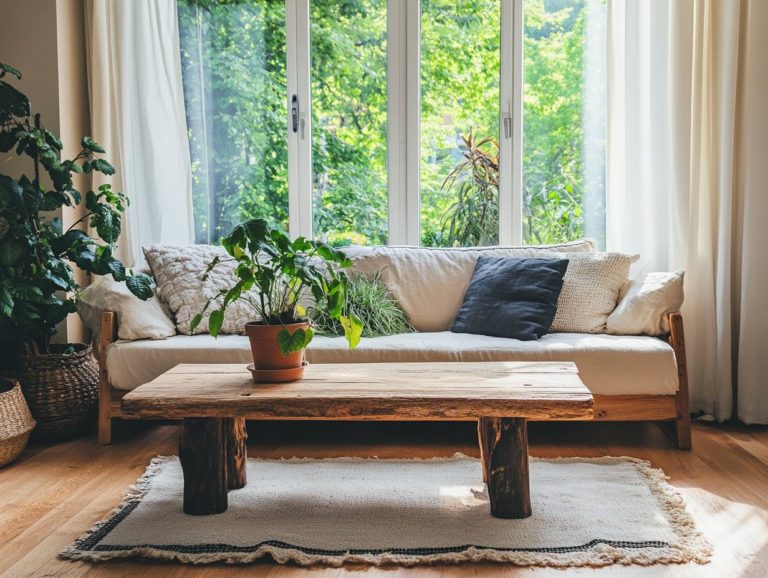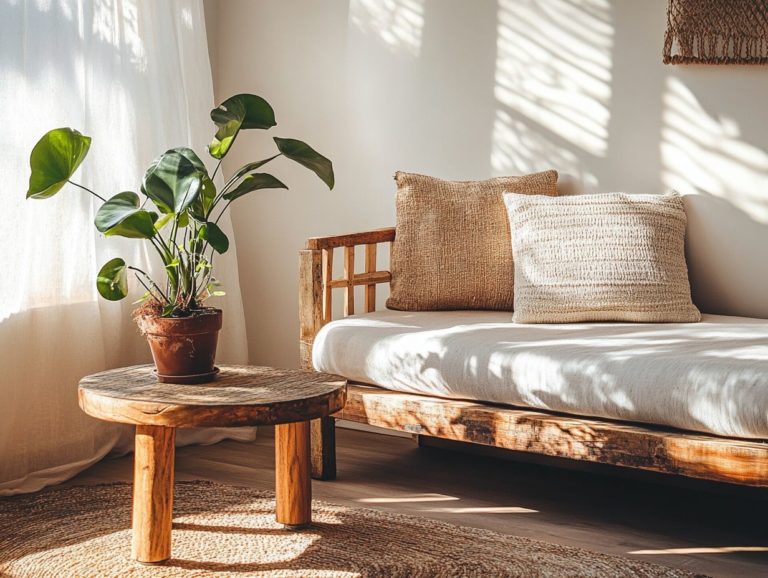How to Upcycle Sustainable Materials at Home
Upcycling transcends mere trendiness; it represents a creative and sustainable method of transforming unused materials into something both beautiful and functional.
This exploration delves into the myriad benefits of upcycling, highlighting its positive environmental impact alongside the notable cost savings it can provide.
You ll uncover eco-friendly materials to incorporate, discover inspiring DIY projects to ignite your journey, and gather invaluable tips for successful upcycling.
Witness remarkable before-and-after transformations that vividly illustrate the power of creativity intertwined with sustainability.
Get ready to unleash your inner designer while making a meaningful difference!
Contents
- Key Takeaways:
- Benefits of Upcycling Sustainable Materials
- Choosing Sustainable Materials for Upcycling
- DIY Upcycling Ideas for Home
- Tips for Successful Upcycling
- Examples of Upcycled Sustainable Materials
- Frequently Asked Questions
- What is upcycling and how can I do it at home?
- Why is upcycling sustainable?
- What are some easy upcycling projects I can do at home?
- Do I need any special skills to upcycle sustainable materials at home?
- Where can I find sustainable materials to upcycle at home?
- How can I involve my family in upcycling projects at home?
Key Takeaways:
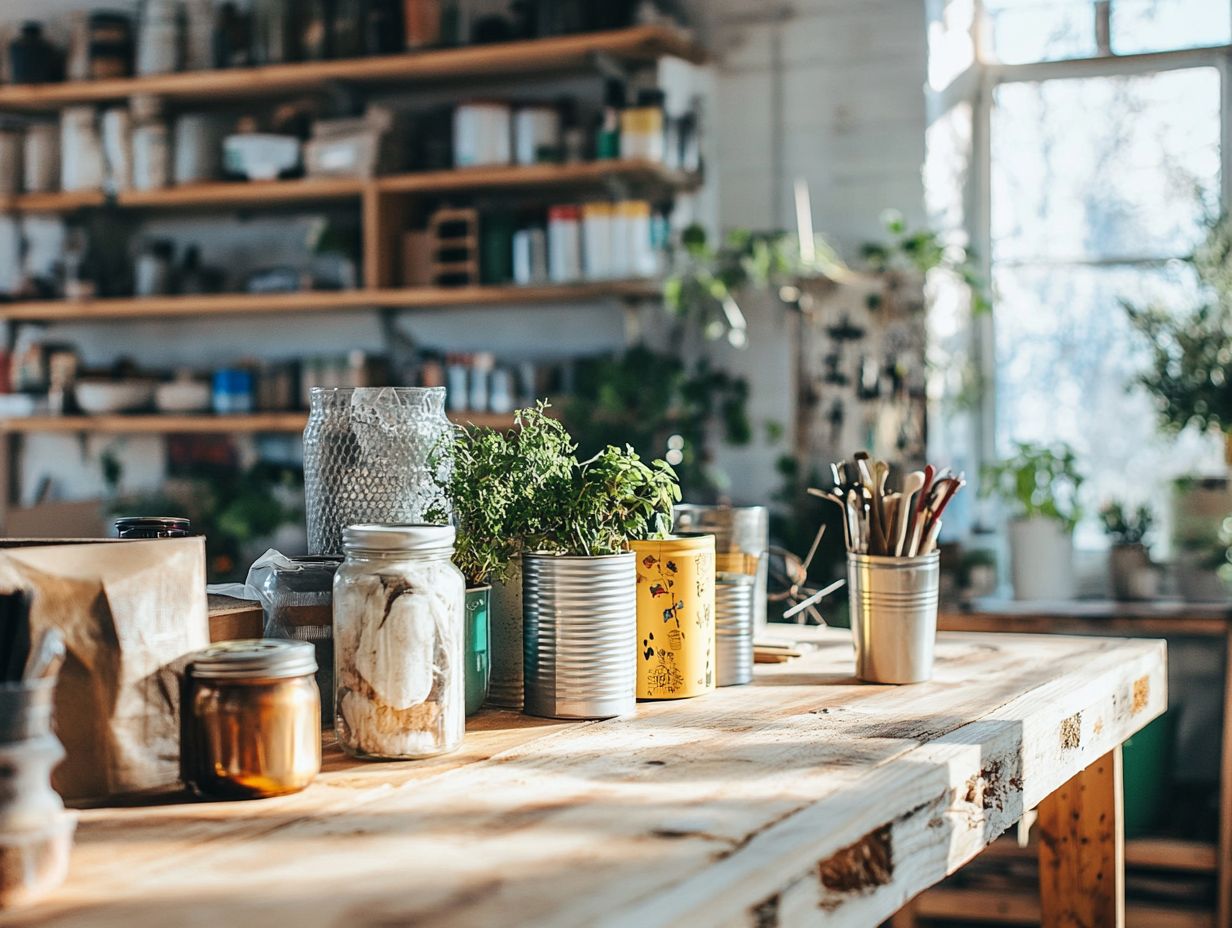
- Upcycling creatively gives new life to materials, reducing waste and supporting sustainability.
- Transforming materials at home is not only eco-friendly but also saves you money!
- Choose eco-friendly items like repurposed fabrics or natural materials for your upcycling projects.
What is Upcycling?
Upcycling is your gateway to transforming waste materials into new products of greater value! It promotes managing materials sustainably while reducing the impact on the environment.
By creatively reusing items like plastic bottles as planters or repurposing old textiles, you re not just saving materials; you re actively contributing to environmental conservation and minimizing landfill waste.
This aligns perfectly with the practices championed by the U.S. Environmental Protection Agency.
This trend traces its roots back to the 1990s when consumers began to awaken to the environmental implications of their purchasing choices. Upcycling is a powerful strategy within the larger framework of sustainable living, enabling you and your community to shrink your carbon footprints and embrace a circular economy.
Consider the elegance of turning discarded wooden pallets into chic furniture or reimagining glass jars as stylish storage solutions. These examples highlight the creativity and resourcefulness that define this movement.
By engaging in such eco-friendly practices, you re not just making a positive impact on the planet; you re also fostering a culture of innovation and responsibility toward the environment.
Benefits of Upcycling Sustainable Materials
Upcycling sustainable materials presents a wealth of advantages that extend beyond personal creativity; it also plays a significant role in environmental conservation.
By embracing upcycling, you have the opportunity to transform discarded items such as empty shoe boxes and kitchen storage containers into functional pieces of art. This not only minimizes landfill waste but also encourages innovative recycling practices, allowing you to contribute meaningfully to a more sustainable future.
Environmental Impact
The environmental impact of upcycling is truly profound. It significantly aids in reducing landfill waste and lessening your carbon footprint by repurposing items that would otherwise be tossed aside.
With the backing of initiatives from the U.S. Environmental Protection Agency, upcycling conserves valuable resources and ignites innovative practices that bolster sustainability across various sectors, particularly in fashion.
Consider the staggering statistic that over 9 billion tons of plastic waste have accumulated on our planet. Upcycling presents a compelling solution to this escalating crisis. For instance, when discarded plastic bottles are transformed into new textiles, the fashion industry can markedly decrease its reliance on virgin materials and cut down on energy consumption.
A report from the Ellen MacArthur Foundation underscores this potential, indicating that upcycling can slash carbon emissions by as much as 70%, urging businesses to embrace more circular practices. Together, these initiatives are pivotal in championing environmental protection, curbing landfill waste, and safeguarding natural resources for generations to come.
Cost Savings
Upcycling offers significant cost savings. You can craft functional items from materials you already have on hand, like old clothing and empty containers.
This not only enables sustainable materials management but also sparks your creativity and resourcefulness in daily life.
For instance, imagine transforming an old pair of jeans into trendy tote bags or turning glass jars into chic candle holders all at minimal expense.
Families can dive into repurposing wooden pallets into unique furniture pieces, which saves money and elevates home d cor.
You can also sell many of those upcycled treasures online or at local markets, creating a fantastic opportunity for a side income.
By embracing the art of upcycling, you not only save money but also make a meaningful contribution to environmental sustainability while fostering a sense of community through shared creativity.
Choosing Sustainable Materials for Upcycling
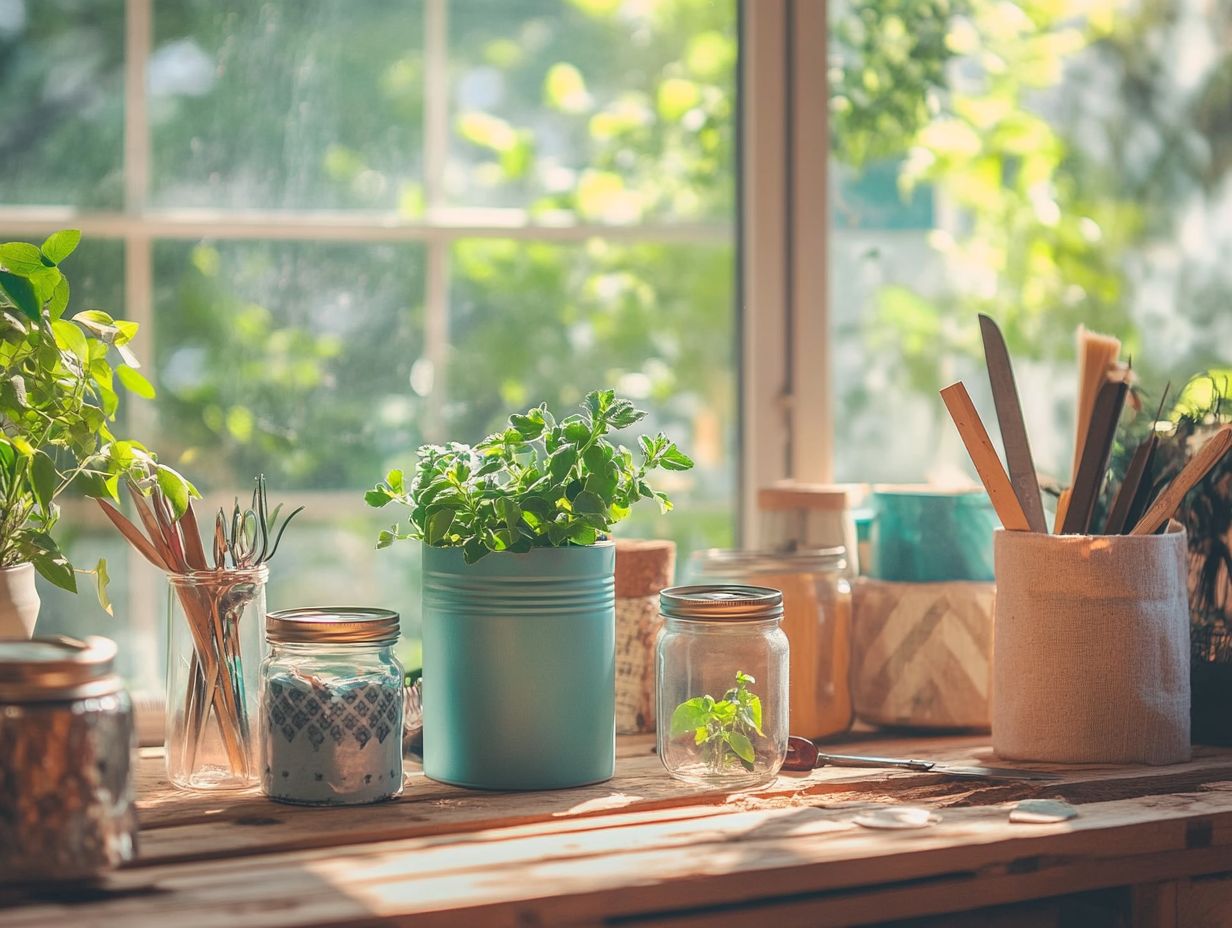
Choosing sustainable materials for upcycling is essential. It ensures your creative process aligns with eco-friendly practices and positively impacts the environment.
By selecting resources like ECONYL regenerated nylon made from discarded fishing nets and fabric scraps you embrace sustainability and engage in innovative projects that redefine how we handle trash and recycling.
This conscious choice lets you create while contributing to a greener future.
Eco-Friendly Options
Eco-friendly upcycling options abound. You can transform various materials from plastics to textiles into fresh creations, showcasing the versatility of sustainable materials management.
By embracing the textile recycling process, you can breathe new life into discarded clothing, crafting unique upcycled fashion pieces that reduce landfill waste and promote sustainable practices within the fashion industry.
Get ready to unleash your creativity! You can create everything from trendy bags made out of old jeans to decorative cushions fashioned from vintage fabrics.
Beyond textiles, everyday household items like glass jars can be repurposed into stylish storage solutions or chic candle holders, demonstrating how even the most ordinary materials can enjoy a second life.
The benefits of using recycled materials extend far beyond aesthetics; they significantly decrease the carbon footprint linked to producing new goods. This fosters an eco-conscious mindset that prioritizes sustainability over a disposable culture, enabling you to make choices that are both stylish and environmentally responsible.
DIY Upcycling Ideas for Home
Dive into DIY upcycling ideas for home decor! Discover creative ways to turn everyday items into unique expressions of your personal style while exploring the best recycled materials for home accessories and demonstrating your commitment to sustainable materials management.
Picture turning empty glass jars into stylish storage solutions or crafting old denim jeans into fashionable bags. These projects encourage eco-friendly practices and foster a culture of repurposing that elevates your living space with flair and purpose.
Creative Projects and Tutorials
Creative projects and tutorials are invaluable resources for anyone eager to explore upcycling. They offer inspiration and guidance for turning discarded items into functional art. Whether you’re turning plastic bottles into charming planters or repurposing textiles into kitchen storage containers, these unique projects reduce waste and cultivate a vibrant community of eco-conscious creators.
Dive into these projects to unlock your creative potential while positively impacting the environment. You can craft colorful wall art with old magazines or make sturdy furniture from wooden pallets the possibilities are nearly limitless!
Gather fun materials like jars and fabric scraps to kickstart your projects! Tutorials break down each step into easy-to-follow parts, providing tips for sourcing additional resources or tools to elevate your crafting experience.
By using your creativity and clever ideas, you can create something truly beautiful and sustainable.
Tips for Successful Upcycling
Implementing effective tips for successful upcycling can greatly elevate your creative process, ensuring your projects are enjoyable and sustainable. Use the right tools and techniques like proper cutting tools and eco-friendly adhesives to transform materials like cardboard and textiles into stunning pieces that reflect sustainable practices.
Tools and Techniques
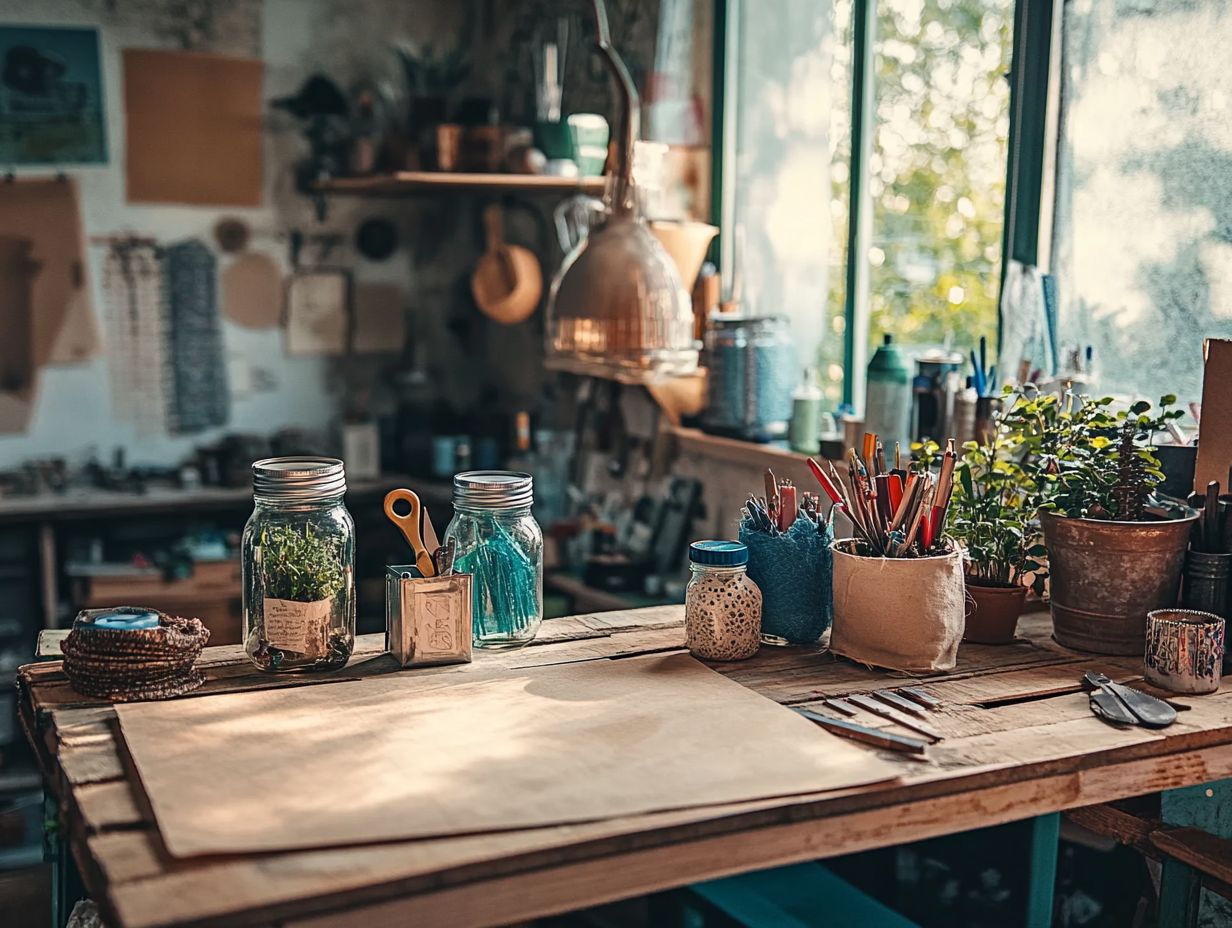
Using the right tools and techniques is essential for your successful upcycling journey. Learn how to transform discarded materials into beautiful, functional items. Whether it s cutting tools or sewing machines, mastering best practices for working with plastic, glass, and textiles will elevate your projects while keeping sustainability at the forefront.
As a beginner, tools like rotary cutters and utility knives are invaluable for precision cutting. Hot glue guns offer versatility for quick assembly. A simple sewing kit can work wonders, allowing you to turn fabric remnants into stylish bags or eye-catching home decor pieces.
Incorporating techniques like decoupage, which involves decorating an object by gluing on paper cutouts, or using chalk paint can add unique finishes to recycled furniture. By mastering these tools and techniques, you create one-of-a-kind items while embracing the principles of sustainability.
Examples of Upcycled Sustainable Materials
Examples of upcycled sustainable materials beautifully illustrate the creative potential of reimagining waste. By learning about sustainable materials: the key to an eco-friendly home, you can transform items that typically end up in landfills into valuable resources and embrace a new perspective on sustainability.
Consider projects like turning denim into stylish bags or repurposing old textiles. These endeavors inspire you to explore unique upcycling projects while underscoring the significance of a creative approach to material supply.
Engaging in such practices allows you to contribute to sustainability while celebrating innovation and artistry.
Start your upcycling adventure today and turn your trash into treasure!
Inspiring Before and After Transformations
Inspiring before-and-after transformations reveal the astounding potential of upcycling. They showcase how seemingly useless items can be reimagined into stunning creations that redefine their purpose.
Imagine a jacket crafted from deadstock fabric or a planter skillfully fashioned from a plastic bottle. These unique projects highlight creativity and resourcefulness in the recycling fashion industry.
Consider the humble wooden pallet. It can be transformed into a chic coffee table, enhancing both functionality and aesthetics in any living space.
Similarly, think about glass jars repurposed into stylish storage containers. They infuse rustic charm into your kitchen while also reducing waste.
These examples show that the upcycling breathes new life into discarded items. It encourages you to think outside the box.
As you embark on your own creative endeavors, remember that the beauty of upcycling lies in the personal touch and unique flair each transformation can bring.
Frequently Asked Questions
What is upcycling and how can I do it at home?
Upcycling is the process of transforming old or discarded materials into something new and useful. To upcycle sustainable materials at home, start by collecting items such as glass jars, old clothes, or scrap wood. You can enhance your efforts by sourcing local sustainable materials for your home and finding creative ways to repurpose them instead of throwing them away!
Why is upcycling sustainable?

Upcycling is sustainable because it reduces waste that goes into landfills. It also decreases the need for new materials to be produced.
By upcycling, we can conserve resources like water and energy that would be used in the production of new materials.
What are some easy upcycling projects I can do at home?
There are many easy upcycling projects you can do at home! Consider turning old t-shirts into tote bags, repurposing glass jars into candle holders, or creating wall art from scrap wood.
You can also find inspiration for upcycling projects by searching online or attending local workshops.
Do I need any special skills to upcycle sustainable materials at home?
No, you do not need any special skills to upcycle sustainable materials at home. Upcycling is all about using your creativity and finding new ways to repurpose old items.
Anyone can do it with a little bit of patience and determination!
Where can I find sustainable materials to upcycle at home?
You can find sustainable materials to upcycle at home by checking your own items! Look for old clothes, furniture, or kitchenware, and explore what you need to know about upcycled materials.
You can also visit thrift stores, garage sales, or local swap meets to find unique items to repurpose.
How can I involve my family in upcycling projects at home?
You can involve your family in upcycling projects at home by making it a fun and creative activity! Have them help collect materials, come up with ideas, and assist with the actual upcycling process.
This is a great way to bond as a family while also promoting sustainable habits.




